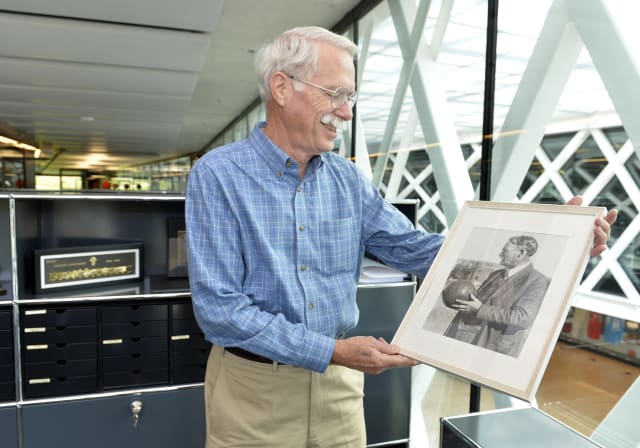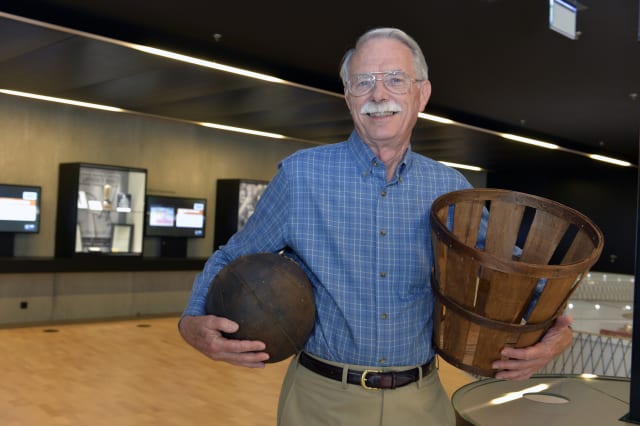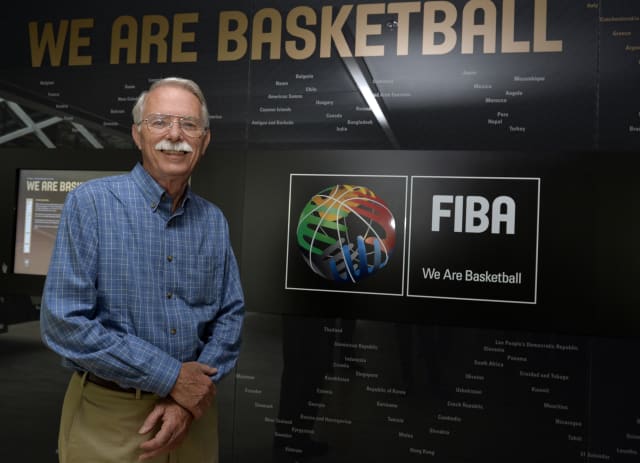Grandson of basketball's inventor pays FIBA a visit
MIES - James P Naismith, the namesake and grandson of Dr James Naismith who invented basketball, recently visited FIBA at its headquarters on the outskirts of Geneva.Following a tour of the House of Basket
MIES - James P Naismith, the namesake and grandson of Dr James Naismith who invented basketball, recently visited FIBA at its headquarters on the outskirts of Geneva.
Following a tour of the House of Basketball, he took time to answer a few questions.
FIBA.com: What are your impressions of the House of Basketball?
Naismith: It's a very impressive setting. It's a great outreach to people who love basketball. I see the opportunity to provide a lot of information and to use a fairly limited space for multiple purposes. Basketball fans have to love it and particularly as they can see so much information about the heroes they had when they were growing up.
FIBA.com: The exhibition space is named the Naismith Arena, in honour of your grandfather. Do you think he would have liked it?
Naismith: It's hard to say because it's so different from what I'm sure he was used to in his time. But I think the attention to individuals - coaches, players, referees, the names of countries and teams and the federations that are a part of FIBA - he would have loved because his focus was always on people.

FIBA.com: What are your memories of your grandfather?
Naismith: Unfortunately he died in 1939 and I was born in 1936. I was only three years old when he died. I had a picture taken with him, but I do not remember him. However, my dad was the youngest of five children and the oldest was my aunt and her children were almost one generation older than my dad. So those children knew their Granddad well. They called him Papa Jim.
FIBA.com: What did your family tell you about him?
Naismith: The fascinating thing to me was my first cousin Peggy who described him as a sweet man, which was not often what you heard as a description for a man. But what that tells me is this person is very sensitive, very much aware of the people around him and very kind. What is particularly interesting to me is that my cousin Stewart used the same word to describe him. So I think that is a particularly good description and also those two cousins are very sweet people (laughs). I think there was a connection there.
FIBA.com: You attended the climax of the 2014 FIBA Basketball World Cup in Spain. What was that experience like?
Naismith: We had great seats, practically on the court for the last three games. The atmosphere was different to what we're used to back in the US. My wife Beverly and I were sitting in the middle of the Serbian section during the Final and we made some friends. They were very passionate and were all over the place hollering as loud as they could.
FIBA.com: Is it fair to say that your grandfather would be proud of the impact basketball has today?
Naismith: That would be the thing that would please him most - to see the positive influence in young people's lives coming simply from playing the sport well. Like he used to say: "Play it hard and play it according to the rules". That's life - play it hard and play it by the rules.

FIBA.com: Let's think back to how he invented basketball. He was a physical education teacher who came up with the game to help kids stay active in the winter.
Naismith: Yes, they were trying to stay in shape during the winter when it was cold and snowing in Massachusetts. They didn't like what they had to do and he was challenged to come up with something they would enjoy. The story is that he tried several games. He took soccer (football) and changed it to where you could play it inside, but that didn't work; lacrosse didn't work; (American) football didn't work; rugby didn't work (laughs).
In the last few months, we discovered a partial set of handwritten notes in which he describes the procedure he went through in thinking up the game of basketball. He starts playing it in his head. He's got 18 men playing this game in his head and then he can finally see how they are moving the ball down the court and making baskets. His comment was "I've never played a game so hard in my life as the game I played that night on my bed". He had to come up with it for the next day. It was his last chance as nothing else had worked.
FIBA.com: Would he be surprised at how basketball has evolved?
Naismith: I think that if he walked in today, he would just be amazed at not only the number of people that play the game but that a whole industry is devoted to it because he was not into that at all. The thing that he would recognise is that he came up with a game that people love to play.
FIBA.com: Is it fair to say that your late brother, Ian, was in charge of maintaining the heritage and legacy of your grandfather?
Naismith: The family got together several years ago and it involved the written rules of the game - the typed rules. Something needed to be done with them.
Ian, my sister Frances Anne, my step-mother Katherine and I all got together because all efforts to place the rules where they would be valued and protected up to that point had not been successful. I found out over the years that all those efforts also included some by Granddad. He had tried to place the written rules at McGill University in Montreal where he had been a theology student and got his first doctoral degree (in theology). That didn't work. There had been some other discussions. My dad had talked to some people, I had talked to some people, to where it was close to a decision and then the vision was not there.
Ian was in the better position - because of his business, family and so forth - to devote the time necessary in heading a campaign to find a way to get these rules protected, valued and available to the public. He was willing to take that and he did. This is what led to the final auctioning of the rules and that didn't just jump up. It was difficult to get anything done when there was no obvious value. I mean, you have two pieces of paper and how do you value something like that? It made sense to auction them simply because you can't value something that doesn't have something that is equal.
And the way that has worked, the gentleman who purchased the written rules is now working with the University of Kansas, where Granddad spent about 40 years of his life working with young people. The rules will be preserved and displayed there. Kansas University are building a big addition to their athletic facility to house them. All of that is really good and we're really pleased.

FIBA.com: Can you tell us about your involvement with the Naismith Memorial Basketball Hall of Fame's Board of Trustees?
Naismith: The Board of Trustees is a money-raising group made up of people who love the game and know how to get resources to support the Hall of Fame and what it does. The reason I'm on there is because I have a good last name. I'm kind of an ambassador to bring the family understanding to the Hall of Fame, which is really a great opportunity. We've met some great people on that Board. I did not become active until my brother died and I was the only grandchild left with the name so it was kind of obvious that they would want me, to see if I could fill that role.
FIBA.com: You look a lot like your grandfather. Do you maintain the look on purpose?
Naismith: No (laughs). The only thing I've done with the look dates back to 1979. The Naismith name is a Scottish name. Granddad was born in Canada, but both of his parents were born in Scotland. We had an opportunity to visit Scotland and I told Beverly when we arrived there: "I've never let facial hair grow but I'm going to let my moustache grow to see if there is any genetic connection. And if you tell me you don't like it, it comes off the next day". I grew it and I've had it ever since.
FIBA